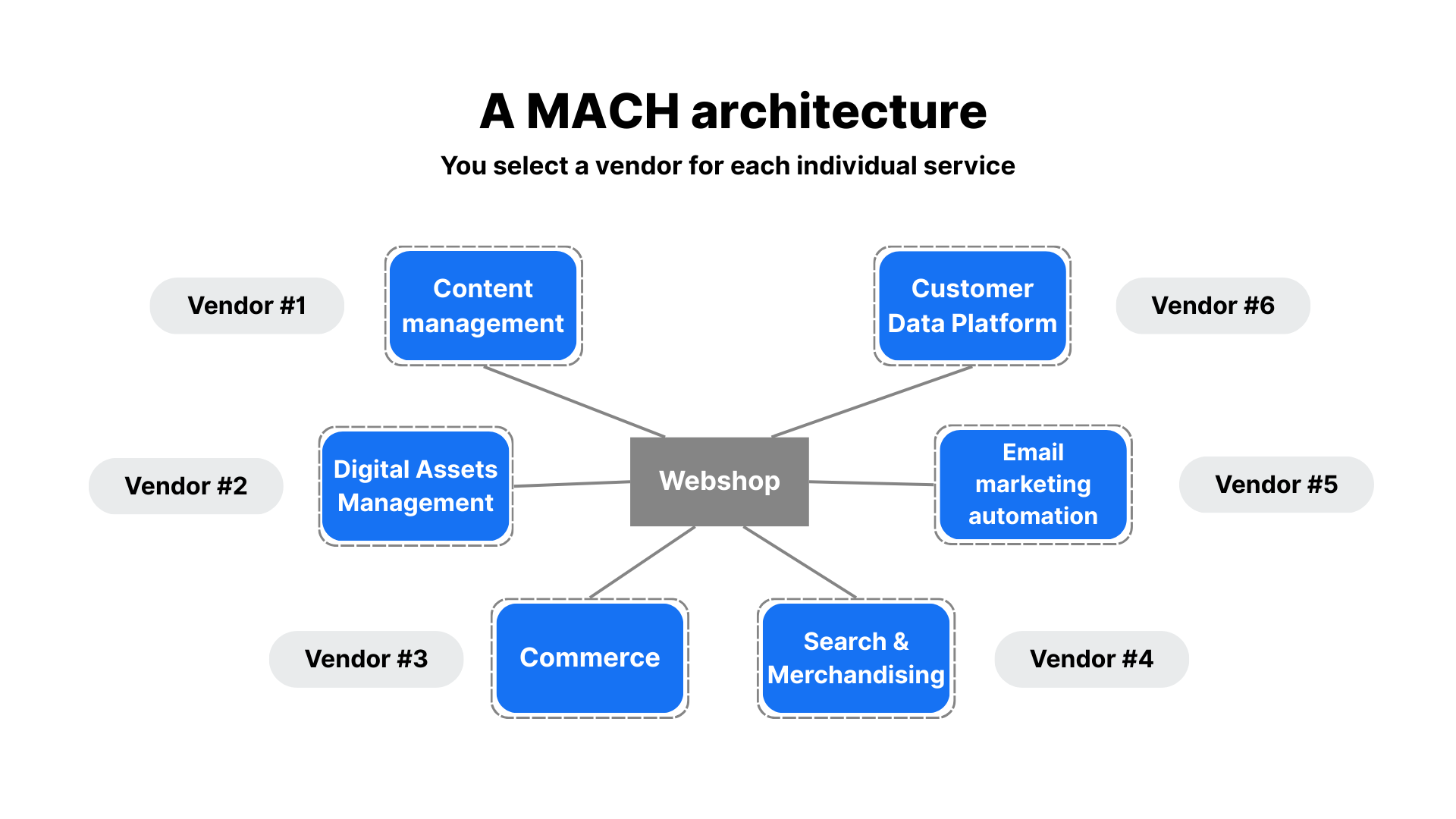Composable Commerce is a strategy in which the IT architecture is built by combining various best-of-breed services from different vendors into a single e-commerce environment. This allows you to create your ideal platform. These services are connected to each other, making it easy to swap out individual components when your business needs change. Moreover, the services are always cloud-hosted, ensuring scalability. As a result, peak periods become less of a bottleneck. This modular approach is based on a MACH architecture and ensures that changes are less risky and less expensive compared to other IT architecture strategies.
An All-in-One solution (such as a Digital Experience Platform) is often seen as the somewhat limiting predecessor of Composable Commerce. With this setup, you purchase a complete package from a single vendor. Essentially, you’re making a trade-off: it’s easier to set up, but because you’re choosing a standard package, the services you get might not fully meet your company’s specific needs. An All-in-One system is also more rigid in terms of architecture, making it difficult to modify or replace less suitable components.
Leading IT research firm Gartner, a frontrunner in e-commerce market analysis, defines Composable Commerce as:

You select a vendor for each service, which is individually integrated with the webshop.
In recent years, the number of devices we use to access the internet has grown significantly. As a result, the way we interact with e-commerce sites has also changed. Where desktop used to be the main focus, today we shop via mobile phones, tablets, and even social channels.
To respond quickly and effectively to these changes, e-commerce companies need a platform that can keep up. Composable Commerce enables this with a best-of-breed approach: selecting the most suitable provider for each service so that your overall platform fits your specific needs. These services are connected through Application Programming Interfaces (APIs), allowing them to share data and function seamlessly as one. This way, you can combine commerce services like cart and checkout with catalog and inventory management, and connect content management to search, merchandising, forms, and personalization.
This modular approach to IT architecture offers five key advantages over traditional commerce platforms:
Because you choose each service yourself, every component of your platform fits your unique requirements. You can select the top provider for each service, ensuring consistent high quality across your platform.
You decide when to replace a service. If your needs evolve—say, due to customer growth—you can quickly integrate a more suitable solution. You can also add or remove services at any time after the initial setup.
Composable services are cloud-based by design, making them inherently scalable. High-traffic moments like Black Friday become much easier to manage, as the infrastructure adapts automatically to demand.
Choosing an all-in-one suite from a single vendor often means you're locked into their ecosystem, making it difficult to switch providers. With a Composable setup, you're working with multiple vendors, which gives you more independence and flexibility.
The modular nature of Composable Commerce gives you room to quickly test and implement new features or tools. This allows you to stay agile, respond faster to market shifts, and continuously meet customer expectations.
All-in-One and Composable are two fundamentally different approaches to building your commerce platform. Each caters to different business needs, so it’s essential to determine which model suits your goals best.
Make sure to work with an experienced partner who can guide you in selecting the right services and vendors. Choosing the right components requires a deep understanding of the technical and business requirements—down to the smallest detail.
Curious which approach is the best fit for your organization? Or would you like to know how we help our clients choose between All-in-One and Composable Commerce?
Feel free to get in touch, we’re happy to help you explore the right solution.
Four steps to take into consideration before you make the switch.
Continue readingThe smallest changes have massive impact.
Continue readingWant to stay informed about everything happening with Composable Commerce? Sign up for our updates here!
We've built converting e-commerce platforms for our customers for more than 15 years.
You don't just pick a new e-commerce platform. Especially with the sheer volume of available vendors and services. What's the best course of action? Together we will determinate the technical solution that best fits your business goals. Do you want to know how we approach e-commerce projects? We'd love to start a conversation!
Get the right insights!E-Commerce Solutions Specialist
Digital Experience Expert